Systematic Mapping of Digital Gap and Gender, Age, Ethnicity, or Disability
Abstract
1. Introduction
2. Methods
2.1. Context
2.2. Framework
2.3. Definition of Scope
3. Extraction of Relevant Findings from Articles
3.1. RQ1a: How Many Studies Are in the WOS and Scopus Databases from 2000 to 2021; RQ1b: Which Approach Was Used for the Research in the Articles?
3.2. RQ2: Which Are the Most Cited Papers?
3.3. RQ3: What Is the Geographical Distribution of the Principal Authors?
3.4. RQ4a: Which Journals Publish More Articles on This Topic?; RQ4b: What Are the Journal Rankings?
3.5. RQ5: What Are the Topics in This Research Area?
3.6. RQ6: Which Papers Discuss Accessible or Flexible Technology and Digital Gap Diagnostic?
4. Discussion
5. Implications, Limitations, and Future Work
6. Conclusions
Author Contributions
Funding
Institutional Review Board Statement
Informed Consent Statement
Data Availability Statement
Acknowledgments
Conflicts of Interest
References
- World Economic Forum. Error 404: Barriers to Digital Inclusivity. Reports. 2021. Available online: http://reports.weforum.org/global-risks-report-2021/error-404-barriers-to-digital-inclusivity/ (accessed on 18 August 2021).
- Ayob, A.H. E-commerce adoption in ASEAN: Who and where? Future Bus. J. 2021, 7, 4. [Google Scholar] [CrossRef]
- UN News. Global Perspective Human Stories. 2020. Available online: https://news.un.org/en/story/2021/04/1090712 (accessed on 18 August 2021).
- Wolrd Bank Open Data. International Telecommunication Union World Telecommunication/ICT Indicators Database. Mobile Cellular Subscriptions (per 100 People). 2021. Available online: https://data.worldbank.org/indicator/IT.CEL.SETS.P2?most_recent_value_desc=true (accessed on 5 June 2021).
- Liptrott, M. Tackling the Digital Divide: The Shift from Access to Capacity. Int. J. Public Adm. Digit. Age 2016, 3, 70–84. [Google Scholar] [CrossRef][Green Version]
- Vercruysse, J.; Reid, F.; World Economic Forum. The Fourth Industrial Revolution Can Close the Digital Divide. This Is How. 2018. Available online: https://www.weforum.org/agenda/2018/09/how-do-we-close-the-digital-divide-in-the-fourth-industrial-revolution/ (accessed on 31 October 2021).
- Nguyen, M.H.; Hargittai, E.; Marler, W. Digital inequality in communication during a time of physical distancing: The case of COVID-19. Comput. Hum. Behav. 2021, 120, 106717. [Google Scholar] [CrossRef] [PubMed]
- The 2030 Agenda for Sustainable Development. Sustainable Development Goal 4 (SDG 4). La Asamblea General Adopta la Agenda 2030 para el Desarrollo Sostenible. 2015. Available online: https://sdg4education2030.org/the-goal (accessed on 18 August 2021).
- Assembly, G. Resolution adopted by the General Assembly on 11 September 2015. A/RES/69/315 15 September 2015, United Nations, New York. 2015. Available online: https://www.unescwa.org/sites/www.unescwa.org/files/un_resolutions/a_res_69_315_e.pdf (accessed on 21 January 2021).
- Hernández-Ortega, J.; Álvarez-Herrero, J.-F. Gestión educativa del confinamiento por COVID-19: Percepción del docente en España. Rev. Española Educ. Comp. 2021, 38, 129–150. [Google Scholar] [CrossRef]
- Lai, J.; Widmar, N.O. Revisiting the Digital Divide in the COVID-19 Era. Appl. Econ. Perspect. Policy 2021, 43, 458–464. [Google Scholar] [CrossRef]
- García-Díaz, A. Construyendo escuelas resilientes: La educación flexible, la integración y la COVID-19. Rev. Española De Educ. Comp. 2021, 38, 211–227. [Google Scholar] [CrossRef]
- Tomczyk, L.; Eliseo, M.A.; Costas, V.; Sanchez, G.; Silveira, I.F.; Barros, M.-J.; Amado-Salvatierra, H.R.; Oyelere, S.S. Digital divide in Latin america and Europe: Main characteristics in selected countries. In Proceedings of the Iberian Conference on Information Systems and Technologies, CISTI, Coimbra, Portugal, 19–22 June 2019. [Google Scholar] [CrossRef]
- Gu, X.; Zhu, Y.; Guo, X. Meeting the “Digital Natives”: Understanding the Acceptance of Technology in Classrooms. J. Educ. Technol. Soc. 2013, 16, 392–402. [Google Scholar]
- Bahia, K.; Delaporte, A. The State of Mobile Internet Connectivity 2020. GSMA Reports. 2020, p. 61. Available online: https://www.gsma.com/mobilefordevelopment/wp-content/uploads/2019/07/GSMA-State-of-Mobile-Internet-Connectivity-Report-2019.pdf (accessed on 18 August 2021).
- Vial, G. Understanding digital transformation: A review and a research agenda. J. Strateg. Inf. Syst. 2019, 28, 118–144. [Google Scholar] [CrossRef]
- Van Deursen, A.J.; Van Dijk, J.A. The first-level digital divide shifts from inequalities in physical access to inequalities in material access. New Media Soc. 2019, 21, 354–375. [Google Scholar] [CrossRef]
- Dohse, D.; Lim, C.Y. “Bad Neighborhood” and Internet Adoption in Poor Countries: What is behind the Persistent Digital Gap? Growth Chang. 2017, 49, 241–262. [Google Scholar] [CrossRef]
- Antikainen, M.; Uusitalo, T.; Kivikytö-Reponen, P. Digitalisation as an Enabler of Circular Economy. Procedia CIRP 2018, 73, 45–49. [Google Scholar] [CrossRef]
- Ghisellini, P.; Cialani, C.; Ulgiati, S. A review on circular economy: The expected transition to a balanced interplay of environmental and economic systems. J. Clean. Prod. 2016, 114, 11–32. [Google Scholar] [CrossRef]
- Horan, D. Enabling integrated policymaking with the sustainable development goals: An application to Ireland. Sustainability 2020, 12, 7800. [Google Scholar] [CrossRef]
- Lopez-Sintas, J.; Lamberti, G.; Sukphan, J. The social structuring of the digital gap in a developing country. The impact of computer and internet access opportunities on internet use in Thailand. Technol. Soc. 2020, 63, 101433. [Google Scholar] [CrossRef]
- Visvizi, A.; Lytras, M.D.; Damiani, E.; Mathkour, H. Policy making for smart cities: Innovation and social inclusive economic growth for sustainability. J. Sci. Technol. Policy Manag. 2018, 9, 126–133. [Google Scholar] [CrossRef]
- Cantabrana, J.L.L.; Minguell, M.E.; Tedesco, J.C. Inclusion and Social Cohesion in a Digital Society. RUSC. Univ. Knowl. Soc. J. 2015, 12, 44. [Google Scholar] [CrossRef]
- Rodríguez-Abitia, G.; Martínez-Pérez, S.; Ramirez-Montoya, M.; Lopez-Caudana, E. Digital gap in universities and challenges for quality education: A diagnostic study in Mexico and Spain. Sustainability 2020, 12, 9069. [Google Scholar] [CrossRef]
- Chaoub, A.; Giordani, M.; Lall, B.; Bhatia, V.; Kliks, A.; Mendes, L.; Rabie, K.; Saarnisaari, H.; Singhal, A.; Zhang, N.; et al. 6G for Bridging the Digital Divide: Wireless Connectivity to Remote Areas. IEEE Wirel. Commun. 2021, 1–9. [Google Scholar] [CrossRef]
- Meng, G. Nonstandardization Based on Standardization. In Proceedings of the 2016 International Conference on Architectural Engineering and Civil Engineering, Shanghai, China, 9–11 December 2016. [Google Scholar] [CrossRef][Green Version]
- Dymitrowski, A.; Mielcarek, P. Business model innovation based on new technologies and its influence on a company’s competitive advantage. J. Theor. Appl. Electron. Commer. Res. 2021, 16, 2110–2128. [Google Scholar] [CrossRef]
- Akpan, I.J.; Udoh, E.A.P.; Adebisi, B. Small business awareness and adoption of state-of-the-art technologies in emerging and developing markets, and lessons from the COVID-19 pandemic. J. Small Bus. Entrep. 2020, 1–18. [Google Scholar] [CrossRef]
- Oztemel, E.; Gursev, S. Literature review of Industry 4.0 and related technologies. J. Intell. Manuf. 2020, 31, 127–182. [Google Scholar] [CrossRef]
- Ibarra, D.; Ganzarain, J.; Igartua, J.I. Business model innovation through Industry 4.0: A review. Procedia Manuf. 2018, 22, 4–10. [Google Scholar] [CrossRef]
- Hermann, M.; Pentek, T.; Otto, B. Design principles for industrie 4.0 scenarios. In Proceedings of the Annual Hawaii International Conference on System Sciences, Koloa, HI, USA, 5–8 January 2016; pp. 3928–3937. [Google Scholar] [CrossRef]
- Wang, S.; Wan, J.; Li, D.; Zhang, C. Implementing Smart Factory of Industrie 4.0: An Outlook. Int. J. Distrib. Sens. Netw. 2016, 12, 3159805. [Google Scholar] [CrossRef]
- Nunes, M.; Pereira, A.C.; Alves, A.C. Smart products development approaches for Industry 4.0. Procedia Manuf. 2017, 13, 1215–1222. [Google Scholar] [CrossRef]
- Nye, B.D. ITS and the digital divide: Trends, challenges, and opportunities. In Lecture Notes in Computer Science (including subseries Lecture Notes in Artificial Intelligence and Lecture Notes in Bioinformatics); Springer: Berlin/Heidelberg, Germany, 2013; Volume 7926. [Google Scholar] [CrossRef]
- Wang, C.H.; McLee, Y.; Kuo, J.H. Ten Years of Digital Divide Studies: Themes, concepts and relationships. In International Conference on Social Science and Humanity; IACSIT Press: Singapore, 2011; Volume 5. [Google Scholar]
- Wang, C.-H.; McLee, Y.; Kuo, J.-H. Mapping the Intellectual Structure of Digital Divide. Int. J. Soc. Sci. Humanit. 2011, 1, 49. [Google Scholar] [CrossRef]
- Fang, M.L.; Canham, S.L.; Battersby, L.; Sixsmith, J.; Wada, M.; Sixsmith, A. Exploring Privilege in the Digital Divide: Implications for Theory, Policy, and Practice. Gerontologist 2018, 59, e1–e15. [Google Scholar] [CrossRef]
- Ghermandi, A.; Sinclair, M. Passive crowdsourcing of social media in environmental research: A systematic map. Glob. Environ. Chang. 2019, 55, 36–47. [Google Scholar] [CrossRef]
- Livingstone, S.; Helsper, E.J. Gradations in digital inclusion: Children, young people and the digital divide. New Media Soc. 2007, 9, 671–696. [Google Scholar] [CrossRef]
- Baldassarre, M.T.; Caivano, D.; DiMauro, G.; Gentile, E.; Visaggio, G. Cloud Computing for Education: A Systematic Mapping Study. IEEE Trans. Educ. 2018, 61, 234–244. [Google Scholar] [CrossRef]
- Acharya, B.B. Conceptual evolution of the digital divide: A systematic review of the literature over a period of five years (2010–2015). J. Russ. Media J. Stud. 2017, 6, 41–74. Available online: http://hdl.handle.net/10393/36756 (accessed on 18 November 2021).
- Chesser, A.; Burke, A.; Reyes, J.; Rohrberg, T. Navigating the digital divide: A systematic review of eHealth literacy in underserved populations in the United States. Inform. Health Soc. Care 2015, 41, 1–19. [Google Scholar] [CrossRef] [PubMed]
- Intahchomphoo, C. Indigenous peoples, social media, and the digital divide: A systematic literature review. Am. Indian Cult. Res. J. 2018, 42, 85–111. [Google Scholar] [CrossRef]
- Yu, R.P.; Ellison, N.B.; McCammon, R.J.; Langa, K.M. Mapping the two levels of digital divide: Internet access and social network site adoption among older adults in the USA. Inf. Commun. Soc. 2016, 19, 1445–1464. [Google Scholar] [CrossRef]
- Chavarría-Barrientos, D.; Camarinha-Matos, L.M.; Molina, A. Achieving the sensing, smart and sustainable ‘Everything. Int. J. Appl. Eng. Res. 2017, 10, 575–588. [Google Scholar] [CrossRef]
- Chavarría-Barrientos, D.; Batres, R.; Wright, P.K.; Molina, A. A methodology to create a sensing, smart and sustainable manufacturing enterprise. Int. J. Prod. Res. 2018, 56, 584–603. [Google Scholar] [CrossRef]
- Ponce, P.; Meier, A.; Miranda, J.; Molina, A.; Peffer, T. The Next Generation of Social Products Based on Sensing, Smart and Sustainable (S3) Features: A Smart Thermostat as Case Study. IFAC-PapersOnLine 2019, 52, 2390–2395. [Google Scholar] [CrossRef]
- Molina, A.; Ponce, P.; Miranda, J.; Cortés, D. Enabling Systems for Intelligent Manufacturing in Industry 4.0: Sensing, Smart and Sustainable Systems for the Design of S3 Products, Processes, Manufacturing Systems, and Enterprises; Springer Nature: Basingstoke, UK, 2021. [Google Scholar]
- Boy, G.A. From rigid to flexible—From virtual to tangible an evolution of human-centered design. In Congress of the International Ergonomics Association; Springer: Cham, Switzerland, 2018; pp. 54–63. [Google Scholar] [CrossRef]
- Longoria, I.A.-I.; Molina, A.; Bustamante-Bello, R. Smart and Connected Systems for the Non-typical User: Design Methodology to Observe the Outliers. In International Conference on Applied Human Factors and Ergonomics; Springer: Cham, Switzerland, 2021; Volume 260. [Google Scholar] [CrossRef]
- Kitchenham, B. Procedures for performing systematic reviews. Keele Univ. UK Natl. ICT Aust. 2004, 33, 1–26. [Google Scholar]
- Alvarez-Icaza, I.; Molina, A.; Bustamante-Bello, R. Connected Platforms for the Non-typical User: Design Methodology to Observe the Outliers. Int. J. Comput. Commun. Eng. 2020, 9, 122–133. [Google Scholar] [CrossRef]
- Petersen, K.; Feldt, R.; Mujtaba, S.; Mattsson, M. Systematic mapping studies in software engineering. In Proceedings of the 12th International Conference on Evaluation and Assessment in Software Engineering (EASE), Bari, Italy, 26–27 June 2008. [Google Scholar] [CrossRef]
- García-González, A.; Ramírez-Montoya, M.-S. Systematic mapping of scientific production on open innovation (2015–2018): Opportunities for sustainable training environments. Sustainability 2019, 11, 1781. [Google Scholar] [CrossRef]
- Velásquez-Duran, A.; Ramirez-Montoya, M.-S. Research management systems: Systematic mapping of literature (2007–2017). Int. J. Adv. Sci. Eng. Inf. Technol. 2018, 8, 44–55. [Google Scholar] [CrossRef]
- Jabareen, Y. Building a Conceptual Framework: Philosophy, Definitions, and Procedure. Int. J. Qual. Methods 2009, 8, 49–62. [Google Scholar] [CrossRef]
- Chen, W.; Li, X. Digital inequalities in American disadvantaged urban communities: Access, skills, and expectations for digital inclusion programs. Inf. Commun. Soc. 2021, 24, 1–18. [Google Scholar] [CrossRef]
- Mariscal, J.; Mayne, G.; Aneja, U.; Sorgner, A. Bridging the gender digital gap. Economics 2019, 13, 1–12. [Google Scholar] [CrossRef]
- PAHO—PanAmerican Health Organization. People over 60 have been hardest hit by COVID-19 in the Americas. News: PAHO Calls on Countries to Adapt Health Systems to Better Meet the Needs of Older Adults. 2020. Available online: https://www.paho.org/en/news/30-9-2020-people-over-60-have-been-hardest-hit-covid-19-americas (accessed on 24 October 2020).
- Davis, H.; Farmer, J. Including the Rural Excluded: Digital Technology and Diverse Community Participation. In Digital Participation through Social Living Labs; Chandos Publishing: Oxford, UK, 2018. [Google Scholar] [CrossRef]
- World Health Organization. Disability and Health. Disability—A Public Health Issue. 2020. Available online: https://www.who.int/news-room/fact-sheets/detail/disability-and-health (accessed on 5 June 2021).
- Moher, D.; Liberati, A.; Tetzlaff, J.; Altman, D.G. Preferred Reporting Items for Systematic Reviews and Meta-Analyses: The PRISMA Statement. PLOS Med. 2009, 6, e1000097. [Google Scholar] [CrossRef]
- Harzing, A.-W.; Alakangas, S. Google Scholar, Scopus and the Web of Science: A longitudinal and cross-disciplinary comparison. Scientometrics 2016, 106, 787–804. [Google Scholar] [CrossRef]
- Mongeon, P.; Paul-Hus, A. The journal coverage of Web of Science and Scopus: A comparative analysis. Scientometrics 2016, 106, 213–228. [Google Scholar] [CrossRef]
- Durán Domínguez, A.; Río Rama, M.D.; Álvarez García, J. Bibliometric analysis of publications on wine tourism in the databases Scopus and WoS. Eur. Res. Manag. Bus. Econ. 2017, 23, 8–15. [Google Scholar] [CrossRef]
- Pranckutė, R. Web of science (Wos) and scopus: The titans of bibliographic information in today’s academic world. Publications 2021, 9, 12. [Google Scholar] [CrossRef]
- Haddaway, N.R.; Bernes, C.; Jonsson, B.-G.; Hedlund, K. The benefits of systematic mapping to evidence-based environmental management. AMBIO 2016, 45, 613–620. [Google Scholar] [CrossRef]
- Kitchenham, B.; Pretorius, R.; Budgen, D.; Brereton, O.P.; Turner, M.; Niazi, M.; Linkman, S. Systematic literature reviews in software engineering-A tertiary study. Inf. Softw. Technol. 2010, 52, 792–805. [Google Scholar] [CrossRef]
- Bauer, M.; Gaskell, G. Classical Content Analysis: A Review. In Qualitative Researching with Text, Image and Sound; SAGE Publications Ltd.: Thousand Oaks, CA, USA, 2011. [Google Scholar] [CrossRef]
- Ramírez-Montoya, M.-S.; Lugo-Ocando, J. Systematic review of mixed methods in the framework of educational innovation. Comunicar 2020, 28, 9–20. [Google Scholar] [CrossRef]
- GSMA. Internet of Things. Mobile IoT Deployment Map. 2021. Available online: https://www.gsma.com/iot/deployment-map/ (accessed on 18 November 2021).
- Kolodeznikova, I.V.; Kuznetsova, I.V.; Pronchev, G.B. Particularities of gender gap in the digital era. Astra Salvensis 2018, 6, 871–880. [Google Scholar]
- König, R.; Seifert, A.; Doh, M. Internet use among older Europeans: An analysis based on SHARE data. Univers. Access Inf. Soc. 2018, 17, 621–633. [Google Scholar] [CrossRef]
- Freddolino, P.P.; Lee, V.W.P.; Law, C.-K.; Ho, C. To Help and to Learn: An Exploratory Study of Peer Tutors Teaching Older Adults about Technology. J. Technol. Hum. Serv. 2010, 28, 217–239. [Google Scholar] [CrossRef]
- Vicente, V.A.Q. An unequal decade for older people who came late to cyberspace|Una década desigual para los mayores que llegaron tarde al ciberespacio. Sociol. Probl. E Prat. 2011, 65, 51–68. [Google Scholar]
- Hunter, E.; Travers, H.; Gibson, J.; Campion, J. Bridging the triple divide: Performance and innovative multimedia in the service of behavioural health change in remote Indigenous settings. Australas. Psychiatry 2007, 15, S44–S48. [Google Scholar] [CrossRef] [PubMed]
- Dombrowski, L. Socially just design and engendering social change. Interactions 2017, 24, 63–65. [Google Scholar] [CrossRef]
- Dombrowski, L.; Harmon, E.; Fox, S. Social justice-oriented interaction design: Outlining key design strategies and commitments. In Proceedings of the 2016 ACM Conference on Designing Interactive Systems: Fuse, Brisbane, Australia, 4–8 June 2016; pp. 656–671. [Google Scholar] [CrossRef]
- Navarrete, R.; Luján-Mora, S. Bridging the accessibility gap in Open Educational Resources. Univers. Access Inf. Soc. 2018, 17, 755–774. [Google Scholar] [CrossRef]
- Sanchez-Prieto, J.; Trujillo-Torres, J.M.; Gómez-García, M.; Gómez-García, G. The generational digital gap within dual vocational education and training teachers. Eur. J. Educ. Res. 2020, 9, 1557–1567. [Google Scholar] [CrossRef]
- Ayanso, A.; Cho, D.I.; Lertwachara, K. The digital divide: Global and regional ICT leaders and followers. Inf. Technol. Dev. 2010, 16, 304–319. [Google Scholar] [CrossRef]
- Pinto, S.C.D.; Masson, D.; Villeneuve, E.; Boy, G.; Urfels, L. From requirements to prototyping: Application of human-system integration methodology to digital twin design. Proc. Des. Soc. 2021, 1, 1617–1626. [Google Scholar] [CrossRef]
- Adler-Milstein, J. From Digitization to Digital Transformation: Policy Priorities for Closing the Gap. J. Am. Med. Assoc. 2021, 325, 717–718. [Google Scholar] [CrossRef] [PubMed]
- Zhu, Y. Research on the human-computer interaction design in mobile phones. In Proceedings of the 2020 International Conference on Computing and Data Science, CDS 2020, Stanford, CA, USA, 1–2 August 2020; pp. 395–399. [Google Scholar] [CrossRef]

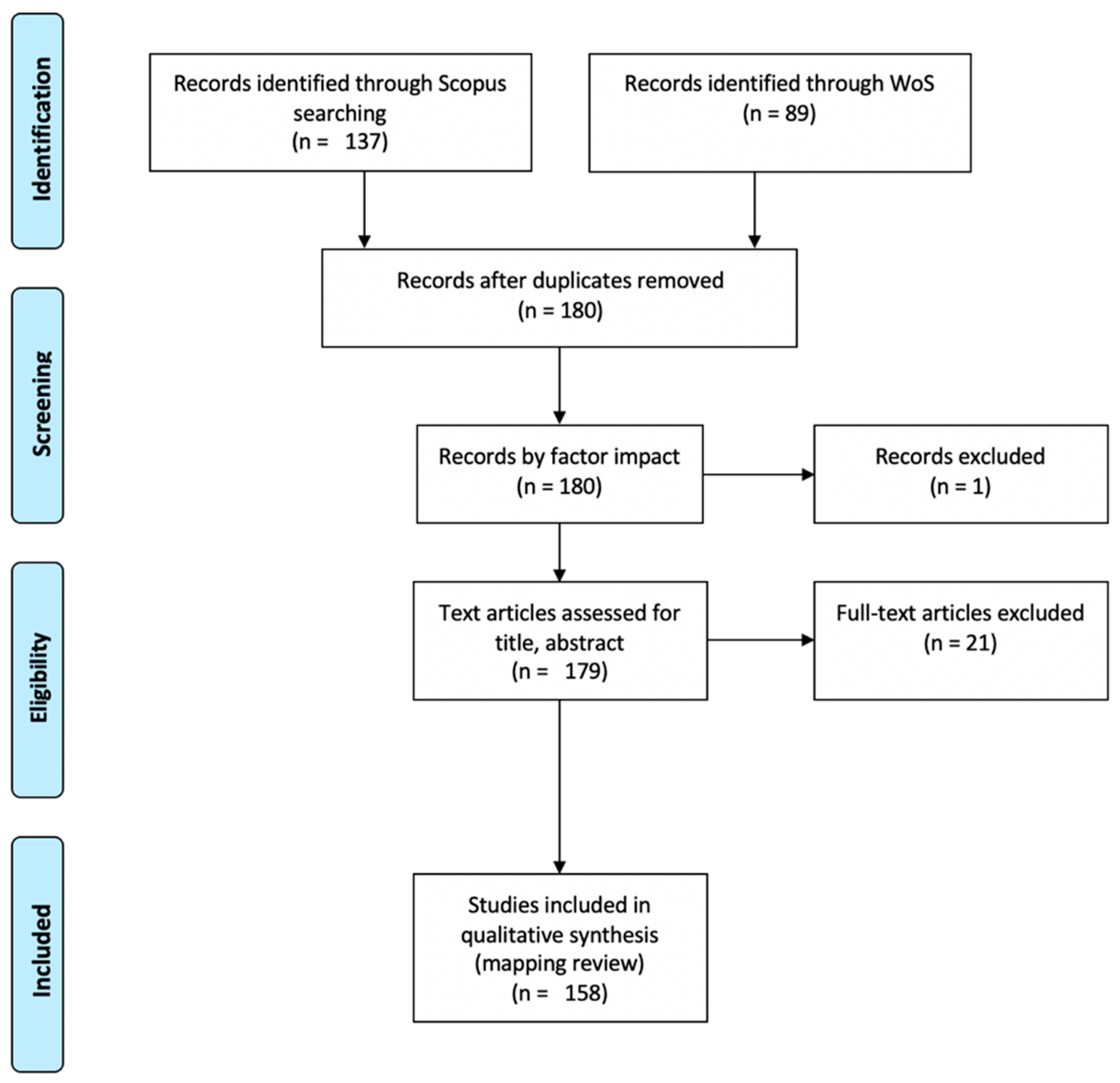
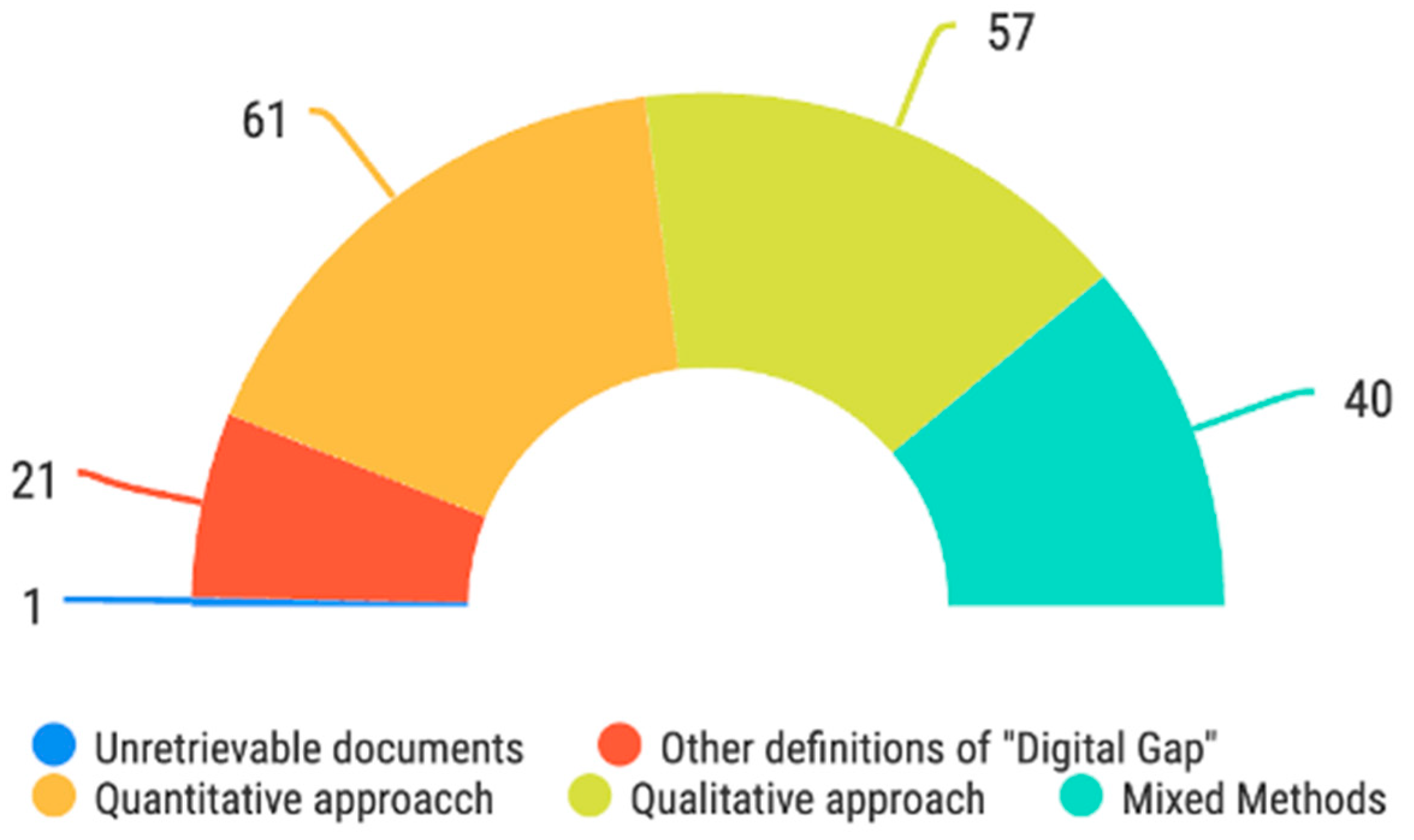
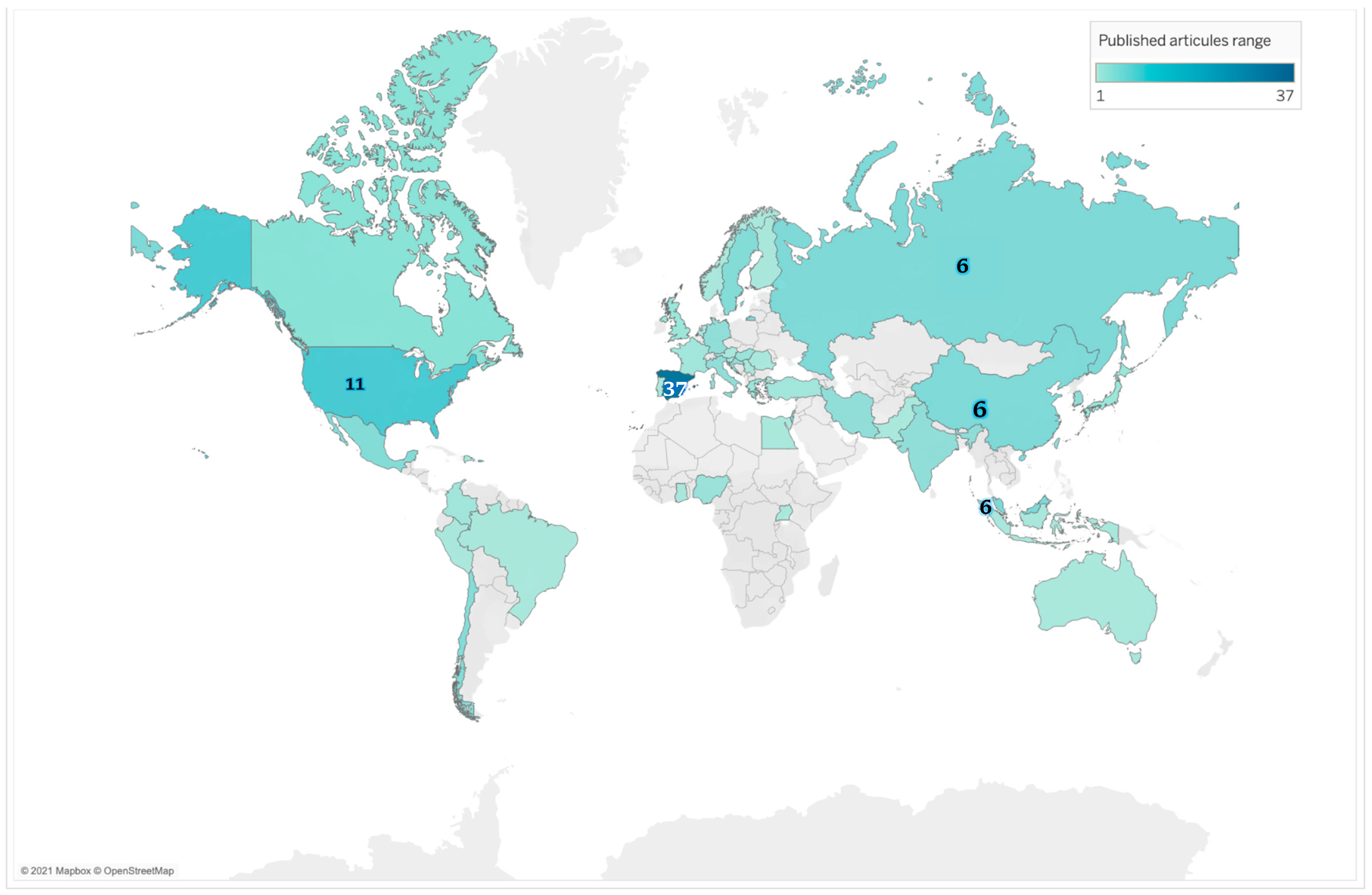
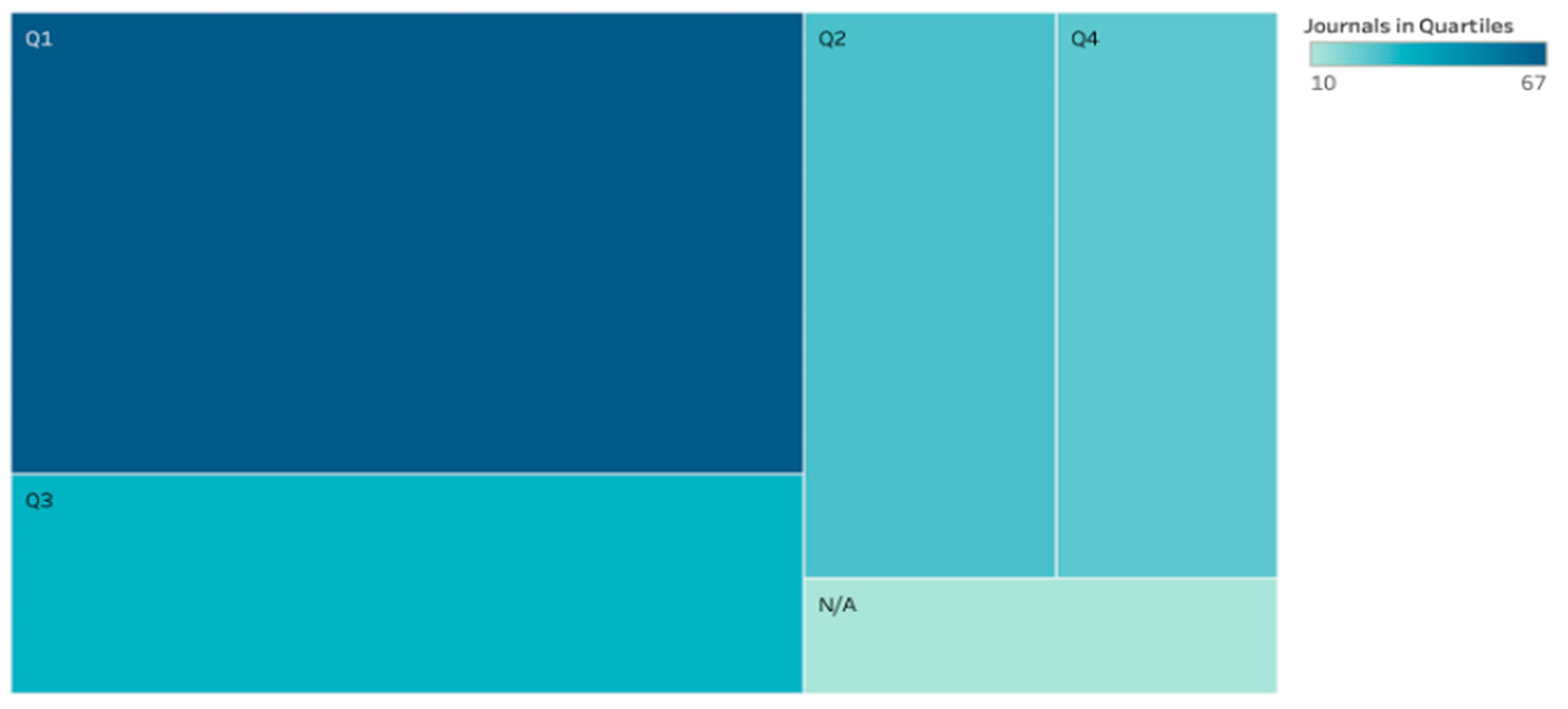
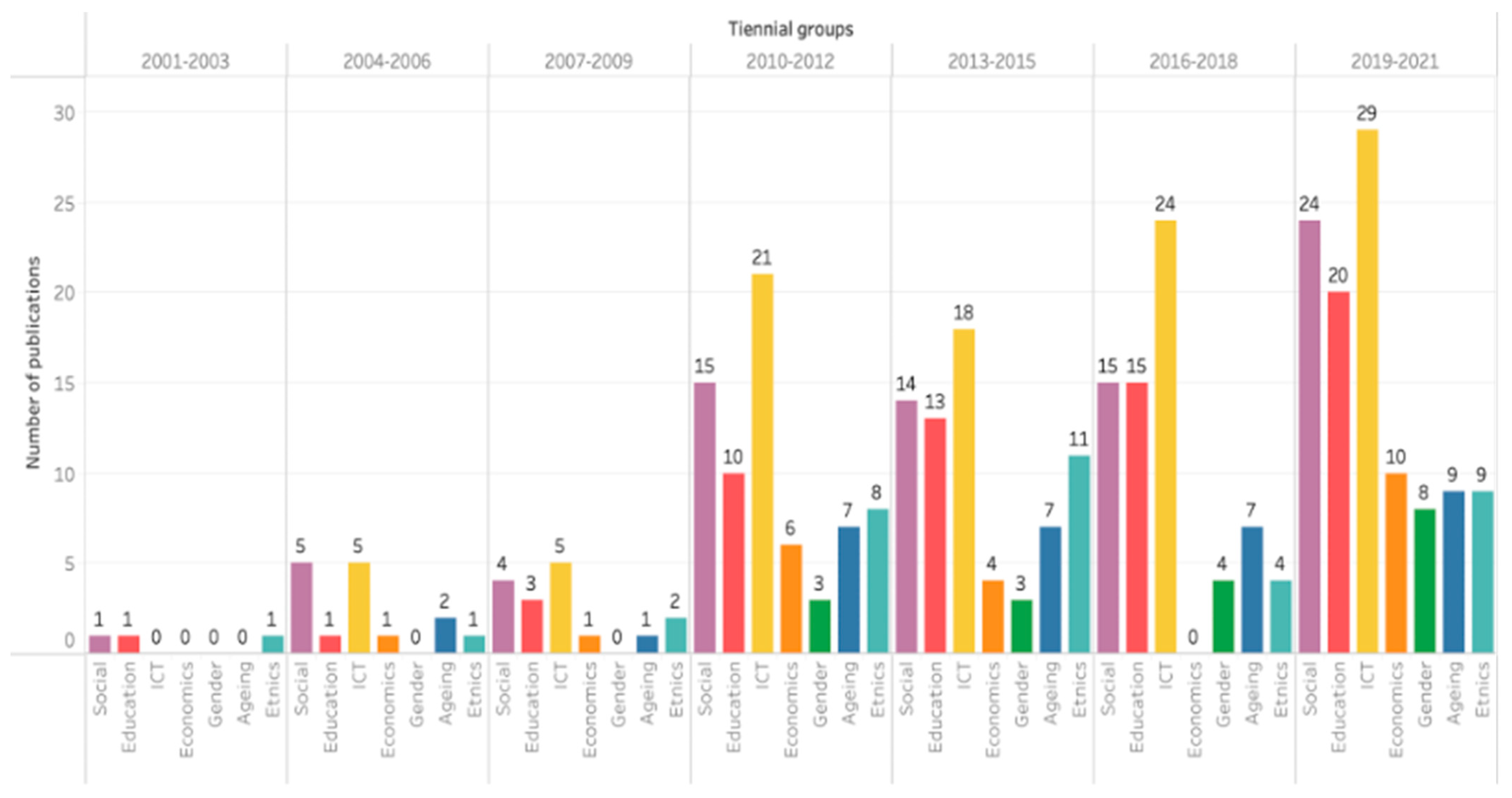

| Research Questions | Desired Outcome |
|---|---|
| RQ1a: How many studies are in the WOS and Scopusdatabases from 2000 to 2021? RQ1b: Which approach was used for the research in the articles found? | A number of pieces in Scopus and WOS Number of duplicate articles Number of qualitative studies Number of quantitative studies Number of mixed-methods studies |
| RQ2: Who are the authors of the most cited articles? | Most cited authors Most cited articles |
| RQ3: What is the geographical distribution of the principal authors? | Countries where the authors are from Countries in which the issue is a common concern |
| RQ4a: Which journals publish the most articles on this topic? RQ4b: What are the journals’ rankings? | Journals and publications Journals’ rankings: Q1, Q2, Q3, Q4 (or not available) |
| RQ5: What are the topics in this research area? | Who suffers from the digital gap and in which environments |
| RQ6: What are the opportunity areas in this line of research? | Accessible or flexible technology strategies and digital divide diagnosis |
| Strategy | Description |
|---|---|
| Databases | WoS and Scopus |
| Search string or Keywords in Web of Science database | Topic in (SCI-EXPANDED), Social Sciences Citation Index (SSCI), Arts & Humanities Citation Index (A&HCI): “digital gap” OR “technological gap” AND gender OR age * OR rural * OR disab * Refined By: Document Types: ArticlesWeb of Science Index: Social Sciences Citation Index (SSCI) or Science Citation Index Expanded (SCI-EXPANDED) or Arts & Humanities Citation Index (A&HCI) NOT Document Types: Proceedings Papers or Early Access. Timespan: 01 January 2000 to 01 August 2021 |
| Search string or Keywords in Scopus database | Article title, Abstract, Keywords: “digital gap” OR “technological gap” AND gender OR age * OR rural * OR disab * Refined by: PUBYEAR > 1999 AND LIMIT-TO DOCTYPE, “article” AND LIMIT-TO “journal.” |
| Timeframe | 2000 to 2021 (1 August) |
| Document type | Article |
| Language | All |
| Study field | Unspecified |
| Type of access | Unspecified |
| Inclusion criteria | Primary studies about digital gap Studies describing the digital gap related to age, gender, rural (context) and disabilities. Only articles in journals |
| Exclusion criteria | Duplicate articles of the same research Studies without complete data (unretrievable documents) Studies unrelated to the concept of the digital gap in technology access Systematic literature mappings |
| Journal | ID | Cited | Quartile |
|---|---|---|---|
| Sustainability | 22 | 16 | Q2 |
| 124 | 4 | ||
| 83 | 3 | ||
| 23 | 2 | ||
| 126 | 1 | ||
| Telecommunications Policy | 150 | 114 | Q1 |
| 84 | 20 | ||
| 56 | 3 | ||
| 115 | 1 | ||
| 45 | 0 | ||
| 152 | 0 | ||
| Universal Access in the Information Society | 73 | 70 | Q1 |
| 61 | 3 | ||
| 7 | 0 | ||
| 53 | 0 |
| Cluster | Categorization Topic | Key Terms |
|---|---|---|
| Context | Social | Divide; justice; inclu (for inclusive, inclusion); equity. |
| Education | educ (for education, educational); learn (for learner or learning); skill, teach (for teacher, teaching, teach) literacy; train (for training, trainer, trainee); scho (for scholar, school); student. | |
| Information and Communication Technologies | ICT; comm (for communication, communications); tech (for technology, technologies, technological); internet. | |
| Economic | econom (for economy, economics, economic); financ (for finance or financial); product (for production, productivity, products). | |
| Vulnerable population | Gender | wom (for woman or women); gender; femini (for feminist or feminism). |
| Age | old (also for older); age (also for ageing); elder (also for elderly). | |
| Disabilities | disab (for disability or disabled—the term used in the 20th century); accesib (for accessible or access); inclusi. | |
| Ethnics | Indigenous; et (for etnia, ethnicity); rural; low (income); socioeconomic; poverty. |
Publisher’s Note: MDPI stays neutral with regard to jurisdictional claims in published maps and institutional affiliations. |
© 2022 by the authors. Licensee MDPI, Basel, Switzerland. This article is an open access article distributed under the terms and conditions of the Creative Commons Attribution (CC BY) license (https://creativecommons.org/licenses/by/4.0/).
Share and Cite
Longoria, I.A.-I.; Bustamante-Bello, R.; Ramírez-Montoya, M.S.; Molina, A. Systematic Mapping of Digital Gap and Gender, Age, Ethnicity, or Disability. Sustainability 2022, 14, 1297. https://doi.org/10.3390/su14031297
Longoria IA-I, Bustamante-Bello R, Ramírez-Montoya MS, Molina A. Systematic Mapping of Digital Gap and Gender, Age, Ethnicity, or Disability. Sustainability. 2022; 14(3):1297. https://doi.org/10.3390/su14031297
Chicago/Turabian StyleLongoria, Inés Alvarez-Icaza, Rogelio Bustamante-Bello, María Soledad Ramírez-Montoya, and Arturo Molina. 2022. "Systematic Mapping of Digital Gap and Gender, Age, Ethnicity, or Disability" Sustainability 14, no. 3: 1297. https://doi.org/10.3390/su14031297
APA StyleLongoria, I. A.-I., Bustamante-Bello, R., Ramírez-Montoya, M. S., & Molina, A. (2022). Systematic Mapping of Digital Gap and Gender, Age, Ethnicity, or Disability. Sustainability, 14(3), 1297. https://doi.org/10.3390/su14031297








